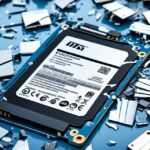Table of Contents
As technology moves forward, getting more from our computers matters a lot. Swapping an old Hard Disk Drive (HDD) for a modern Solid State Drive (SSD) can make a big difference. This guide shows you how to move your data and set up an SSD. You’ll get not just faster speeds but also save energy and get a drive that lasts longer.
SSDs read and write data much quicker than old hard drives. This means your computer will start faster and work more smoothly. Making the HDD to SSD switch is definitely worth it1. Plus, SSDs use less power, so if you use a laptop, its battery will last longer2.
In this guide, you’ll learn about different ways to move your data to an SSD. You can do it yourself with simple copy and paste, or use disk cloning software for a more secure transfer. Knowing these options helps you decide the best way to upgrade.
Key Takeaways
- Upgrading from HDD to SSD leads to noticeably increased system performance.
- SSDs are more energy-efficient, contributing to longer battery life.
- The migration process can involve various methods, including cloning software or manual transfers.
- Understanding the limitations of each method will aid in selecting the best data transfer approach.
- Utilising tools like AOMEI Partition Assistant can streamline the migration process effectively.
Introduction to SSDs and HDDs
Solid State Drives (SSDs) have changed how we store data. They don’t have moving parts, unlike Hard Disk Drives (HDDs). This leads to big benefits like fast speed and more durability. Studies show SSDs are much quicker, which is great for getting data fast and making work more efficient3.
SSDs start up and load apps quicker than HDDs, which are slower in reading and writing data4. Although HDDs have their downsides, they’re often chosen for large storage needs because of their simple design and cost-effectiveness. For example, an 8TB HDD costs much less than an SSD of the same size3.
Meanwhile, SSDs, despite being more expensive, offer quicker performance, less noise, and lower heat output. As mobile devices focus on speed, brands like Samsung and SanDisk are pushing SSDs. They’re now a default in many new laptops. SSDs are also safer for mobile tech because they can handle shocks and vibrations well4.
Why Move Files from HDD to SSD?
Moving files from HDDs to SSDs boosts your computer’s performance. It’s great for both individuals and businesses. SSDs offer many benefits that make them worth considering.
Improved Speed and Performance
SSD’s main benefit is their speed. SSD advantages include quick speed improvement. You’ll see this when your system starts and apps open faster.
SSDs handle tasks quicker than HDDs because they transfer data faster. This leads to enhanced performance5. Switching to an SSD means your computer will work more efficiently.
Energy Efficiency and Durability
SSDs also save more energy than HDDs. They use less power, which means laptops last longer without charging5. Moreover, SSDs last longer and are tougher.
They’re better at protecting your data since they can take more bumps and shocks5. For anyone who wants a reliable and secure storage option, SSDs are the best choice.
How to Transfer Data from an HDD to an SSD
Moving your data from an HDD to an SSD can boost your system’s speed and work rate. It’s important to know the different data transfer methods to make this switch smooth. Which method you choose depends on how much data you have and if you’re comfortable with tech stuff.
Understanding the Transfer Methods
The easiest method to move files is by copy and paste, perfect for small, non-critical files. However, it’s not so good for moving lots of data or full systems. For those bigger jobs, disk cloning is better. It makes an exact copy of your HDD onto the SSD, including the operating system and all your apps. This leads to quicker and more reliable data saving.
Using tools like AOMEI Backupper Professional and Samsung Data Migration can improve the moving process a lot. They allow for secure boot-up after the clone and make changing over to the new drive easy. AOMEI is really flexible, offering different clone options like Disk, System, and Partition Clone. It also lets you clone bigger HDDs to smaller SSDs by only moving the bits that are actually used.
Another bonus of these third-party tools is they let you clone while you keep working, so there’s no downtime. This makes the big task of moving your data less scary. With these data migration techniques, your info is not just moved over—it’s set up for peak SSD performance and durability.
To sum up, while copy and paste is okay for small tasks, better data transfer methods like disk cloning and smart tools increase both speed and trustworthiness of your data movement67.
Moving Data Using Copy and Paste
The copy paste method is an easy way to move files from a hard disk drive (HDD) to a solid-state drive (SSD). This method is great for moving personal files or documents. Make sure the SSD is ready to get data before starting.
Step-by-Step Instructions for Simple Transfers
First, have both your HDD and SSD connected to your computer. Find the files on the HDD you want to transfer, select them, right-click, and hit ‘Copy’. Then, head over to the SSD, right-click where you want the files, and choose ‘Paste’. This is good for moving smaller files or personal items. But remember, moving system files this way can cause problems. They might not work right because their settings and locations can get mixed up.
To avoid these issues, it’s best to check out more detailed advice on copying system files.
Limitations of the Copy and Paste Method
The copy paste method is handy but not great for big files or moving an entire system. For those tasks, cloning software like AOMEI Backupper is usually better. It matches systems more effectively and performs better. Moving system files can be tricky because they need to be installed a certain way to work right after the move8. It’s important to understand these points for a smooth transition. This ensures you get the most out of your SSD16.
FAQ
What is the main difference between HDDs and SSDs?
SSDs have no moving parts, making them faster and more reliable. HDDs use spinning disks which slow them down and can fail more easily.
Why should I migrate my data from an HDD to an SSD?
Switching to an SSD makes your computer run quicker. You’ll see faster starts and open apps faster. SSDs use less power, so they’re good for laptops and last longer if dropped.
What methods can I use to transfer data from an HDD to an SSD?
There are a few ways to move data. You can simply copy small files. For a complete copy, including your system and apps, disk cloning is best.
How do I use the Copy and Paste method for data transfer?
Just choose files on the HDD, copy them, and paste into the SSD. It’s easy but can cause problems with big files or system files.
What are the limitations of the Copy and Paste method?
It’s okay for small files but tough for big ones. You might not move everything needed, like system files, unless you clone everything properly.
Source Links
- https://www.diskpart.com/articles/how-to-transfer-data-from-hdd-to-ssd-7201.html – How to Transfer Data from HDD to SSD Drive in Windows 11/10/8/7?
- https://www.easeus.com/pc-transfer/transfer-data-from-hdd-to-ssd-laptop.html – How to Transfer Data From HDD to SSD Laptop [2 Methods Available]
- https://www.backblaze.com/blog/ssd-upgrade-guide/ – How to Upgrade Your Computer: Migrating from HDD to SDD
- https://www.geeksforgeeks.org/introduction-to-solid-state-drive-ssd/ – Introduction to Solid-State Drive (SSD) – GeeksforGeeks
- https://www.easeus.com/pc-transfer/move-files-from-hdd-to-ssd-windows-11.html – How to Move Files from HDD to SSD Windows 11 | 2 Solid Ways
- https://www.ubackup.com/articles/transfer-data-from-hdd-to-ssd.html – How to Transfer Data from HDD to SSD in Windows 10/11 (2 Ways)
- https://ipwithease.com/how-to-transfer-data-from-hdd-to-ssd/ – How to Transfer Data from HDD to SSD? – IP With Ease
- https://www.linkedin.com/advice/1/how-do-you-migrate-your-data-from-hdd – How do you migrate your data from an HDD to an SSD without losing quality or compatibility?








